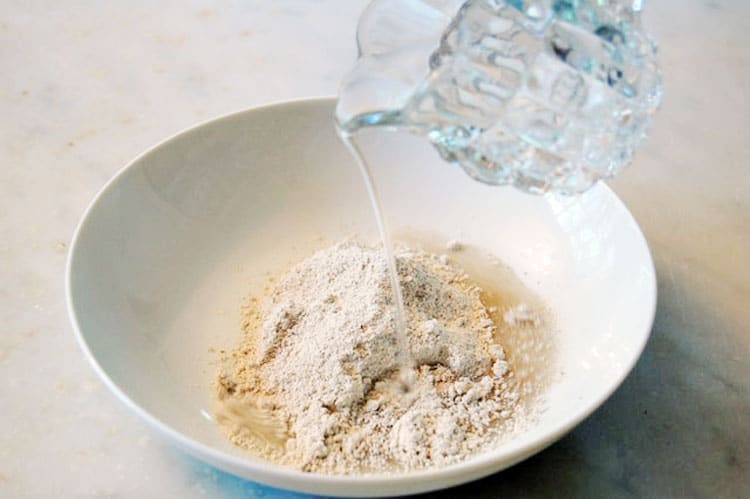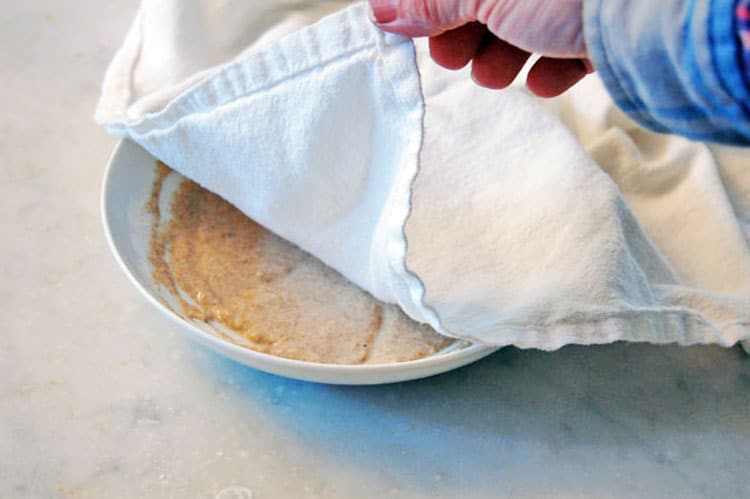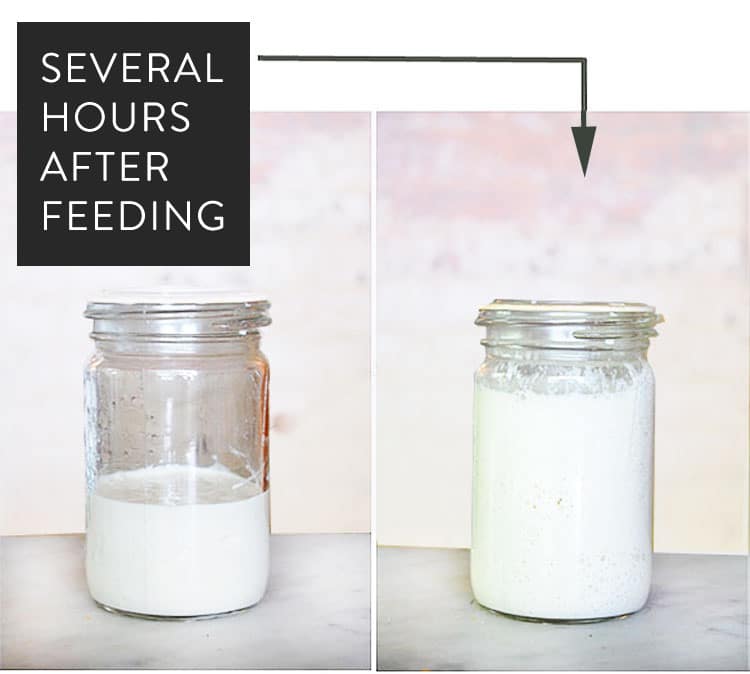Can we be frank? If you're making grilled cheese sandwiches on anything other than sourdough bread there's a good chance you're mental.
So there's that.
I don't really care if you're mental and I firmly believe that we can still be friends because who isn't mental? But I will question almost everything you do from here on in based on this whole sourdough thing. I'm concerned you're also the kind of person who puts ketchup on your grilled cheese.
If you DON'T use sourdough bread for your grilled cheese sandwiches it's entirely possible that up until now you just didn't know any better. Now you do.
There are 2 main reasons to use sourdough bread for grilled cheese sandwiches.
- Sourdough toasts up beautifully on the outside while retaining a good chew on the inside.
- Flavour, flavour, flavour. Or flavor, flavor, flavor for my American friends.
Since building my outdoor cob pizza oven and discovering the world's best bread book The New Artisan Bread in 5 Minutes a Day I've been making a lot of bread. A lot. Some would say too much. Mostly people who are walking behind me. Up until 2 years ago I made sourdough bread from my own starter that I showed you how to make on this website years ago.
But I let my sourdough starter die a sad death and it's time for me to make a fresh batch.
So what is Sourdough exactly?
Do you remember years ago when there was a bit of a fad with people passing around a gross glop of dirty looking glue? You were supposed to take a bit out, separate the rest and pass it along to a bunch of unsuspecting friends. It was like a chain letter but with something you were worried people had sneezed into.
THAT was sourdough starter.
Sourdough starter is what you need to make sourdough bread.
Sourdough starter is basically a mixture of flour and water that’s been left to ferment and turn into liquid yeast.
Sourdough yeast tastes different than regular yeast because it’s fermented and has a slight sour taste to it which gives sourdough its distinct flavour.
O.K. NOW do you want to know how to make this miracle of nature known as sourdough starter that has you catching wild yeast from the air.
I thought you might. I learned how to make natural sourdough starter from the book Wild Fermentation by Sandor Ellix Katz. This book has every possible way to ferment anything. It's a hipster homesteader's dream.
One of the first things you learn in the book is how to catch wild yeast to make sourdough starter. Otherwise known as glop. I made that up. I'm the only person who calls it glop, but it's pretty appropriate if you ask me.
“Catching wild yeast” is a bit of a romanticism. You are, in fact, catching wild yeast, but yeast is pretty much in abundance everywhere. You know when grapes have that white haze on them? YEAST! Yup. The white haze on grapes is yeast.
Would you like to save this stuff?
Yeast is on your hands, in your home, and on the wind. Which is lucky for we sourdough starter makers.
How to Make Sourdough Starter
Steps:
1. Mix ¼ cup clean (filtered or bottled) water with ¼ flour.
Rye flour, whole wheat flour, white flour…whatever you want. I used rye because it apparently ferments quicker than other flours.

Stir it together. Cover it with a cloth.

- Let it sit for a couple of days. After just 8 hours I could already see tiny bubbles starting to form. You’re waiting for bubbles and a slight yeasty smell, like beer. Or … like yeast, I suppose.
- Once you notice bubbles and a yeasty smell (after 2 or 3 days) you can get rid of half of your mixture. Just scoop it out and throw it down the drain. It may have dried out a bit. That’s O.K.
- Add ¼ cup of water and ¼ cup of flour again to the remaining starter, mix and cover up again. Do this every 8-12 hours for the next 2 weeks or so.
- Remove half the starter, then add ¼ cup water and ¼ cup of flour. Wait 8 – 12 hours and do it again. After several days of doing this you’ll notice the bubbles are starting to get bigger.
(Once it came time to add more flour and water I switched over to regular white flour)
- By day 12-15 you’ll notice your starter will start to double in size after you feed it. It won’t just get a bit bubbly, it will literally double in size!

Once your starter reliably doubles in size for several days, you can break out the cigars because you are the proud parent of glop. Some people suggest you keep feeding it on the counter like this for up to a month to really get the sour taste. Those people must not have a life. Because just feeding this starter twice a day for two weeks is enough to make a person crazy. Trust me. By the end of two weeks you’ll be as sick of feeding this starter as you are of feeding your family every night.
Once you have a successful starter you can stick it in the refrigerator until the day before you’re going to make bread. The day before you make bread the starter should be removed from the refrigerator and brought up to room temperature. Once it’s warm, add ¼ cup of bottled water and a ¼ cup of flour. This will help activate the starter and get it bubbly again. 8-12 hours later, do it again. Your starter should now be ready to use.
If you don’t think your starter is doing much you can:
a) put the starter close to an open window so it has more access to wild yeast. (no idea if this is a fable or not, but I did it and it worked)
b) Put the starter in a warmer part of the room, or warmer room in general.
c) Increase the amount of flour and water you add from ¼ cup of each to ½ cup of each
Too much work for a grilled cheese sandwich? Of course it is. You can buy sourdough bread pretty much anywhere now you know. But if you're the curious type or LOVE baking bread you have to do this at least once in your life. If you decide it's too much upkeep ... well that's when you start unloading it on other people by starting yourself a good old fashioned glop sharing chain letter.
Just make sure to cover your mouth when you sneeze around it.





Linda
Dear Karen,
A couple years ago your Christmas list had dried sourdough starter for those of us who can't catch yeast here in Northern Ontario and i was too ill to start it in summer. I've tried searching your site but I am having trouble navigating it as my brain is too busy still farting and draining itself, grrrrrr. I thought it was Christmas list 2021 but I cannot locate that either. I believe I'm using the upgraded site very poorly so please forgive me and I happen to be your elder too, bwahahaha. Respect our dearest Karen, hehehe.
Clare McK
Why do you throw half away? Is it just to keep the quantity under control? Presumably you could use it to get another batch going, or in other recipes.
Any ideas?
Bonnie H.
I find sourdough though has a certain flavour to it.
Thin, dense rye bread on the other hand isn't very flavourful and is thin, yet dense enough that it lets more of the cheese flavour to come through.
connie
Thx Karen for that info. It's in a jar now with a linen napkin on it ..... it's bubbly and sour-ish...So far so good :) Can't wait to bake it.
connie
Hi Karen , HELP ! thought i would try you one more time with this question: I've made the SD starter-it's day 5 now . When should it get transferred to a jar and how do i cover it at that point ? Do i put a secure/ tight lid on it (the metal one that comes with the jar) or just cover with a cloth again? thx.
PS: it's looking and smelling good and sour already.
Karen
Hi Connie. Have you continued to feed it by adding flour and water to it every day? ~ karen!
connie
Hi Karen , y
up- i 've been feeding it daily.
Karen
Hi Connie. You can put it into a jar whenever you want, it makes no difference. :) In fact, I'm starting 3 different sourdough starters on my counter right now and I started all of them in jars. Just cover them with a light cloth like cheesecloth. It just helps keep dust and dirt out while still allowing for the flow of bacteria and allows gasses to be released. You should be feeding it twice a day now. Within the next two weeks it'll start to double in size when you feed it. At that point you can make your first batch of bread. It may not be completely sour but should have some taste to it. The world of sourdough starter is incredibly complex with flavours depending not only the region it was made in but also the hydration level of it. I'm a total sourdough beginner by sourdough standards. There's a lot to learn and a lot of variables so you just have to roll with the punches and learn as you go. Have fun! ~ karen
Renee Ryz
Hubby uses mayo instead of butter on the outside of his bread. Browns nicely, but I want that butter taste! I use a nice soft 100% whole wheat & cheddar. A bit of apple butter on the inside is tasty too!
Renee Ryz
Is there a way to do this whole grain? I can't eat white bread anymore :(... I also remember my aunt doing this and calling it Herman back in the day. I got caught in that friendship bread cult when my kids were young. Got to a point if you started to ask anyone "Hey would you like some..." everyone would say "NO friendship starter NO!" My biggest problem is I hate throwing food away, so I would end up with ALOT of starter.
Nancy S
Yes, you can do it with any flour that has gluten in it. If you have a problem with gluten, you're probably out of luck.
There are a lot of very experience and helpful bread people on http://www.thefreshloaf.com/
alena
I have never baked bread but makes me want to try.
Sourdough bread is the only real bread. All the other stuff that tastes like sawdust .... I don't even understand why it's in the grocery stores. All my life, my mantra has been "If it's not sourdough it's not bread!".
Of course I don't have a bread maker but people used to make bread by hand for centuries. And if I miss it up - my dog loves pizza crust so I am pretty sure she would take of whatever comes of out of my attempt.
Karen
It's pretty hard to make bread so poorly that it's inedible. I mean ... it's bread. ;) ~ karen!
Alena
I am a woman of many talents!
Pauline
Hi Karen!
I read somewhere that flour makes a huge difference in making/baking bread….but I find that my grocery store doesn’t sell anything other the regular stuff….what are your thoughts on flour and what do you use?
Karen
Hi Pauline! Flour does make a huge difference in terms of taste and texture, but I'll tell you, I use regular white flour for making bread and it's always good. I add some interesting flours to it like Red Fife or Rye (1/4-1/2 cup) and just that little bit completely change the structure of the bread. What I'm saying is if all you can get is regular white flour, it's fine to use. Although I seem to have read somewhere that Canadian regular flour is different (finer ground) than American regular flour. ~ karen!
Jessie
I have another tip for grilled cheese--use ghee in place of buttering the outside. IF you keep it in the cabinet (as opposed to the fridge), it's always soft and ready to spread. PLUS higher smoke point means it can be on the heat longer before burning, so the cheese is guaranteed to get ultra melty.
Nancy Blue Moon
Sounds good and I like sourdough bread..I will get a loaf and try it...
connie
Absolutely luv sourdough bread and would luv to try this. One question tho- not sure about when I should transfer the starter from the cloth covered bowl to the jar? Do i put a lid on the jar or leave it open/covered with a cloth. Help !
abbot of unreason
pumpernickel
I live in California and sourdough is everywhere but I miss pumpernickel grilled cheese sandwiches.
ronda
many MANY years ago (like, maybe 50 odd?), my dad brought some sourdough bread AND some starter back from San Francisco. But my mum was not a breadmaker in any way, shape or form. While baking bread IS on my radar, making sourdough may not be. I forget to take my vitamin pill half the time lol!
janpartist
Ummm, it sounds wonderful. I have had several unsuccessful attempts at bread baking in general and that's it for me. But, I do make a great grilled cheese-on rye with 1 slice of cheddar, 1 slice of swiss, and one slice of muenster. we have a wonderful bakery in town that makes wonderful crusty rye with that same sour taste that's in sourdough. I would never turn down a grilled cheese made with sourdough though.
Brian
So you can't do this in that pot thingy you were typing about last week?
Elaine
I remember being given a gray, unappetizing blob of starter back in the late 60's or early 70's. At that time, in my neighborhood in southern Ontario, it was called "Herman". I recall it had to be kept on top of the fridge and fed a certain amount of sugar (I think!) every x number of days.
Kim S
I took a bread making class through our city Adult Education. The teacher said to never put yeast down the drain--you should make sure that goes in the trash. Even after kneading--rub all of those crumblies into the trash! The thought is your drain can be a nice warm moist place with lots of food bits--you don't want to have anything growing in there causing a blockage. I'm not sure if it's the truth, but not willing to test it out. Always made sense to me!
Jody
Thanks--I think. I'm going to have to check the calendar to make sure it is wide open for 2+ weeks. Why do you have to throw half of it away? I don't understand that part.